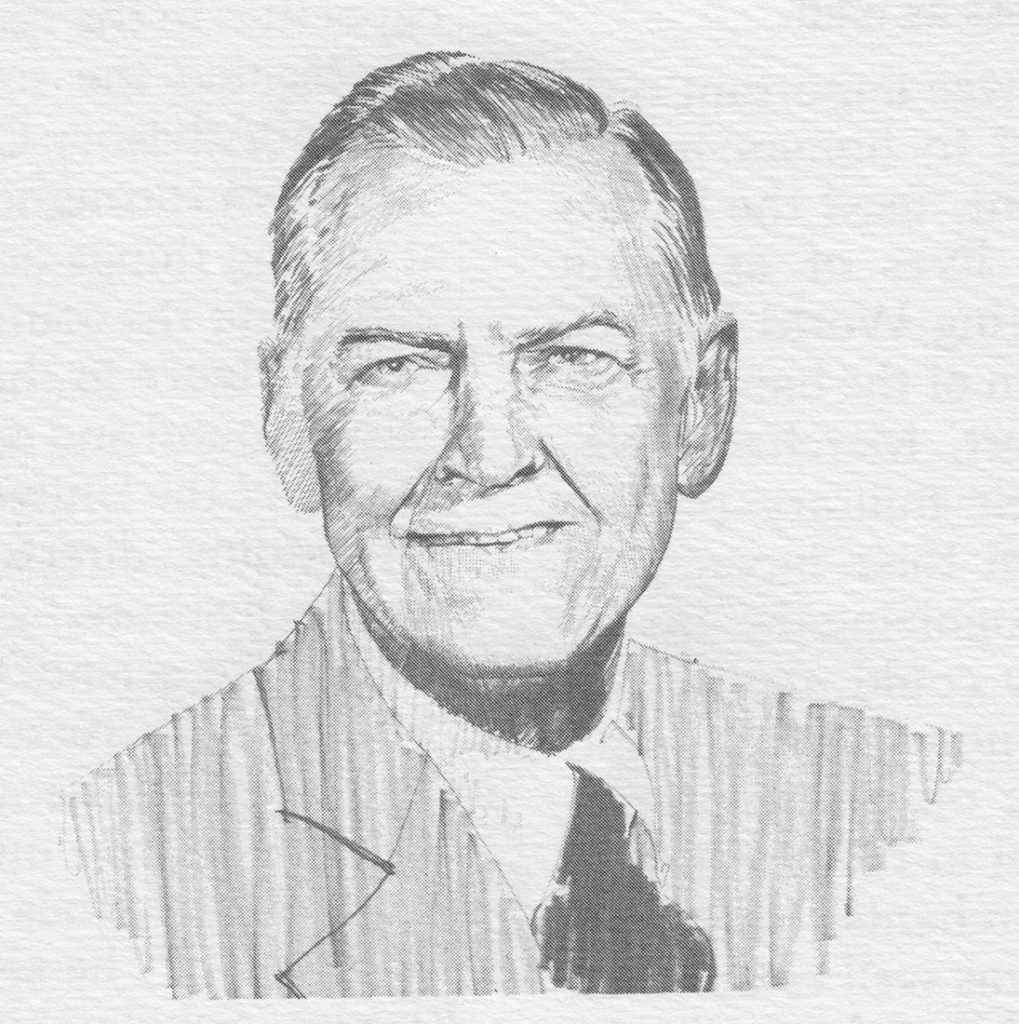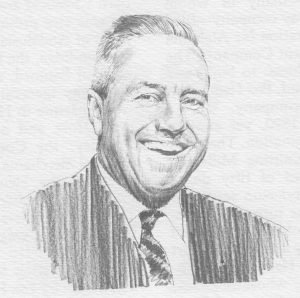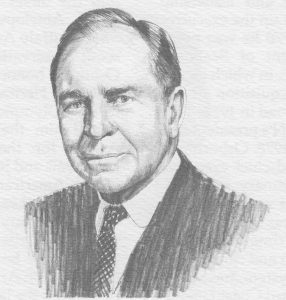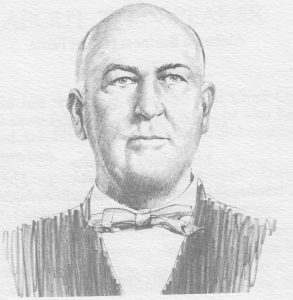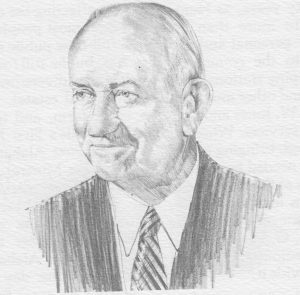Prime F. Osborn III, had the grand total of 65 cents in his pocket when he arrived at The University of Alabama campus as a freshman in 1932. He wanted an education, he wanted at least one job, if not two, and he wanted to become involved in as many campus activities as possible. Despite the difficulty of achieving any of those goals during the Depression, young Osborn managed to find the time and the energy to accomplish them all. In doing so, he established a reputation as a gifted problem-solver and leader-characteristics that would propel him on a long and distinguished career. When he retired in 1982, he was chairman of the board of the nation’s largest railroad system, a nationally honored civic leader, and one of the country’s most highly regarded and articulate supporters of the American free enterprise system.
Born in Greensboro, Alabama, in 1915 to Prime F. and Anne (Fowlkes) Osborn, Prime Osborn III spent the first twelve years of his life on his family’s cotton farm outside of town. In 1922 he moved with his parents and sister to Greensboro, where he graduated from public school before entering The University of Alabama. His gift for organization and his natural ability as a leader quickly became apparent on campus. While supporting himself with a job in the registrar’s office, with a laundry route, and with other jobs, young Osborn excelled at his studies as well as in extracurricular activities. By the time he graduated from the University’s law school in 1939 he had been tapped into virtually all of the campus’ most prestigious academic, social and civic organizations and had served as president of many of them.
His first full-time job as assistant attorney general for the state of Alabama ended when the U.S. entered World War II and Osborn left to join the war effort. After graduating from the army’s Command and General Staff School in 1942, he rose to the rank of lieutenant colonel of artillery and served in the Pacific Theatre (Hawaii, Guam, Saipan, and low Jima), where he was highly decorated for his distinguished service. Osborn returned home after the war to join a law firm, but when he learned of an opening for a lawyer with the Gulf, Mobile, and Ohio Railroad in Mobile, he changed his mind and applied for the position for the railroad instead. That decision, made in 1946, turned out to be one of the most important in his life, for the young lawyer soon found that he had entered what he still calls today “the most fascinating business in the world.”
Railroads and railroad mergers (which became his specialty) were to dominate his career from that point on, and he quickly rose to the industry’s top executive ranks. In 1951, he became general solicitor for Louisville & Nashville Railroad (L&N), and in 1957, vice president and general counsel of Atlantic Coast Line Railroad Company (ACL). As head of ACL’s law department, Osborn was involved in the merger of that company with Seaboard Air Line in 1967, a merger seven years in the making that formed Seaboard Coast Line Railroad Company (SCL).
The formation of SCL was only one of the many mergers Osborn helped engineer, but today it remains one of the highlights of his career. Even larger mergers, however, lay ahead, and with each_ successive one, Osborn’s problem-solving and leadership skills propelled him further up the executive chain of command. By 1970 he was president of SCL and president of Seaboard Coast Line Industries (SCLI), in which capacity he orchestrated the acquisition of the Louisville & Nashville Railroad in 1972. That same year he was made L&N’s s president and chief executive officer. By 1978, Osborn was chairman of the board and chief executive officer of SCLI and its primary railroads, SCL and L&N. The largest and most challenging merger, however, was still to come.
On November 1, 1980, Prime Osborn and Hays T. Watkins, chairman, and chief executive officer of the Chessie System, Inc., completed the merger of Seaboard Coast Line Industries with the Chessie System (Chesapeake & Ohio, Baltimore & Ohio, and Western Maryland railroads) to form the holding company, CSX Corporation. Osborn became chairman of CSX’s s board, Watkins was named president, and the merger they had orchestrated Business Week magazine was characterized as “one of the more remarkable success stories of 1981.”
By 1982, the year Osborn retired as board chairman, CSX Corporation was the world’s largest hauler of coal and the nation’s largest rail system in revenues ($5.4 billion) and assets ($8.1 billion). CSX included the Chessie System Railroads, The Seaboard System Railroad, CSX Beckett Aviation Inc., CSX Minerals Inc., CSX Resources Inc., Florida Publishing Company (the Florida Times-Union, the Jacksonville Journal, and the St. Augustine Record), The New River Company, the Richmond, Fredericksburg and Potomac Railroad Company, and The Greenbrier resort hotel in White Sulphur Springs, West Virginia.
Although Prime Osborn rose to a position of eminence as head of a remarkably successful industrial complex, his professional career has been far from the sole interest in his life. Few top business executives in the country, in fact, have contributed more of their time to local and national civic organizations than has he. Over the years he has served on the board or as an officer of nearly thirty organizations, including colleges, universities, hospitals, religious and charitable institutions.
Not surprisingly, many of these organizations have honored him with the highest awards they can bestow. Jacksonville, Florida named him Man of the Year in 1962. The Boy Scouts of America presented him the Silver Beaver Award (1965), the Silver Antelope Award (1967), and the Silver Buffalo Award (1972), and a lake on a scout reservation has been named in Osborn’s honor. In 1973 he received the Religious Heritage of America Award, and in 1976 Olympic champion Jesse Owen presented him the Bicentennial Brotherhood Award for the National Conference of Christians and Jews. Osborn has also received the Americanism Award from the Anti Defamation League of B’Nai Brith and the Salvation Army’s William Booth Award as well as the Order of Distinguished Auxiliary Service-the latter an award presented by the Salvation Army to only 60 individuals in the U.S. in the last 100 years. In 1982 he was honored with the highest awards bestowed by the Jacksonville Chamber of Commerce and the American Academy of Achievement, and he was inducted into the Alabama Academy of Honor.
Osborn’s professional contributions have been widely noted as well. He is the recipient of honorary doctorates from The University of Alabama, Florida Southern College, and Troy State University. The National Defense Transporation Association named him Transportation Man of the Year in 1981, and in 1982 CSX Corporation endowed the Prime F. Osborn Professorship in Transportation at the University of North Florida. He is married to Grace Hambrick of Brookville, Mississippi, also a graduate of The University of Alabama. They have one son, U.S. Navy Commander Prime F. Osborn, IV, and one daughter, Mary Anne Osborn, a candidate for Holy Orders at the Episcopal Divinity School in Cambridge.
Today Prime Osborn is retired, but as more than one reporter has noted, there is nothing “retiring” about him. His involvement in civic and charitable work continues, as does his lifelong interest in railroads. “The retention of transportation as a private enterprise is absolutely imperative,” he says. “Foremost among that is the railroad system. We have a very great responsibility to preserve it.” No single individual had done more to preserve it than Prime F. Osborn III.

